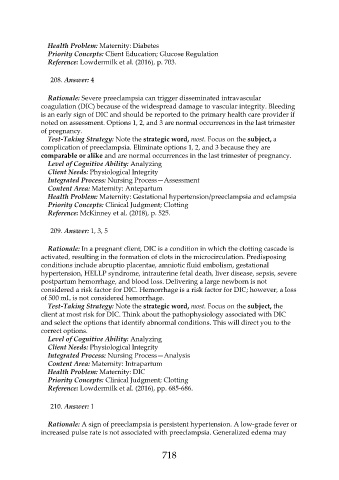Page 718 - Saunders Comprehensive Review For NCLEX-RN
P. 718
Health Problem: Maternity: Diabetes
Priority Concepts: Client Education; Glucose Regulation
Reference: Lowdermilk et al. (2016), p. 703.
208. Answer: 4
Rationale: Severe preeclampsia can trigger disseminated intravascular
coagulation (DIC) because of the widespread damage to vascular integrity. Bleeding
is an early sign of DIC and should be reported to the primary health care provider if
noted on assessment. Options 1, 2, and 3 are normal occurrences in the last trimester
of pregnancy.
Test-Taking Strategy: Note the strategic word, most. Focus on the subject, a
complication of preeclampsia. Eliminate options 1, 2, and 3 because they are
comparable or alike and are normal occurrences in the last trimester of pregnancy.
Level of Cognitive Ability: Analyzing
Client Needs: Physiological Integrity
Integrated Process: Nursing Process—Assessment
Content Area: Maternity: Antepartum
Health Problem: Maternity: Gestational hypertension/preeclampsia and eclampsia
Priority Concepts: Clinical Judgment; Clotting
Reference: McKinney et al. (2018), p. 525.
209. Answer: 1, 3, 5
Rationale: In a pregnant client, DIC is a condition in which the clotting cascade is
activated, resulting in the formation of clots in the microcirculation. Predisposing
conditions include abruptio placentae, amniotic fluid embolism, gestational
hypertension, HELLP syndrome, intrauterine fetal death, liver disease, sepsis, severe
postpartum hemorrhage, and blood loss. Delivering a large newborn is not
considered a risk factor for DIC. Hemorrhage is a risk factor for DIC; however, a loss
of 500 mL is not considered hemorrhage.
Test-Taking Strategy: Note the strategic word, most. Focus on the subject, the
client at most risk for DIC. Think about the pathophysiology associated with DIC
and select the options that identify abnormal conditions. This will direct you to the
correct options.
Level of Cognitive Ability: Analyzing
Client Needs: Physiological Integrity
Integrated Process: Nursing Process—Analysis
Content Area: Maternity: Intrapartum
Health Problem: Maternity: DIC
Priority Concepts: Clinical Judgment; Clotting
Reference: Lowdermilk et al. (2016), pp. 685-686.
210. Answer: 1
Rationale: A sign of preeclampsia is persistent hypertension. A low-grade fever or
increased pulse rate is not associated with preeclampsia. Generalized edema may
718

